source GAIA package: Sx_MilitaryTimes_M6201210205280310_5675.zip Origin key: Sx_MilitaryTimes_M6201210205280310 imported at Fri Jan 8 18:18:06 2016
Tell us
What do you think of your new crackerjacks? Are the new uniforms an improvement? How else would you improve Navy uniforms? Send your comments to navylet@navytimes.com. Please include your name, rate and rating or rank. Your comments may be used as a letter to the editor.
The wait is over: New crackerjacks are coming.
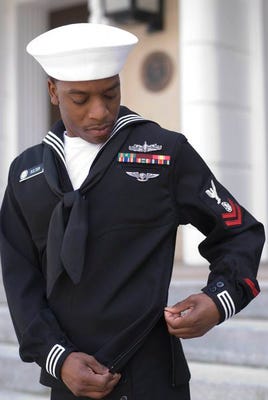 The Navy's top officer has approved the long-awaited overhaul of the iconic dress uniform, a modernization officials say will make them more comfortable and functional. Both dress whites and dress blues, worn by E-6 and below, have been updated after a six-year trial-and-error effort.
The Navy's top officer has approved the long-awaited overhaul of the iconic dress uniform, a modernization officials say will make them more comfortable and functional. Both dress whites and dress blues, worn by E-6 and below, have been updated after a six-year trial-and-error effort.
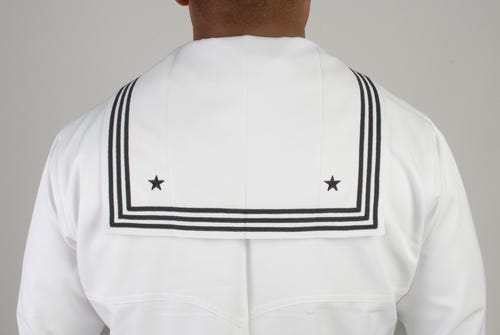 Chief of Naval Operations Adm. Jon Greenert "has approved the revised designs for the service dress blues and the service dress whites," Rear Adm. Tony Kurta, director of military plans and personnel for the chief of naval personnel, said in a May 17 interview. "With the crackerjacks, it has been a long road, and that is for good reasons. We did multiple wear tests. We did tests of both different designs and differing materials."
Chief of Naval Operations Adm. Jon Greenert "has approved the revised designs for the service dress blues and the service dress whites," Rear Adm. Tony Kurta, director of military plans and personnel for the chief of naval personnel, said in a May 17 interview. "With the crackerjacks, it has been a long road, and that is for good reasons. We did multiple wear tests. We did tests of both different designs and differing materials."
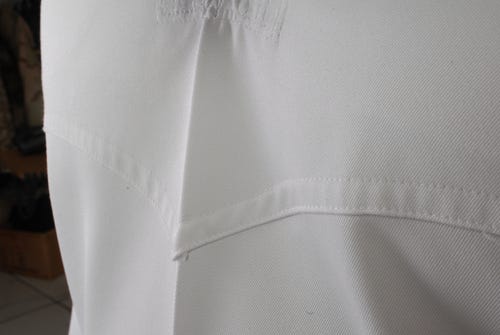 This is the first update for dress whites — worn by all sailors, with women wearing the combination cover instead of a "Dixie cup" — since World War II. The uniform takes cues from full dress whites, a version of crackerjacks phased out in 1940.
This is the first update for dress whites — worn by all sailors, with women wearing the combination cover instead of a "Dixie cup" — since World War II. The uniform takes cues from full dress whites, a version of crackerjacks phased out in 1940.
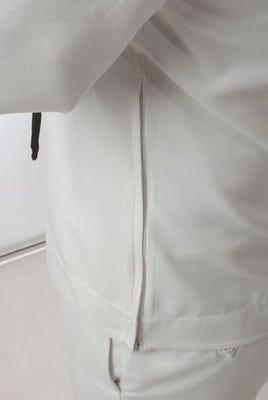 The new whites now mirror the blues in appearance: They feature a yoke around the chest and black piping on the back bib and along the tailored cuffs at the end of the sleeves. Two stars rest in the back bib's corners, just like on the dress blues. The look of the dress blues, worn solely by male sailors, won't change considerably. But the wear may be very different. For one, getting in and out of the pants just got much faster — a zipper has been installed in the front, rendering the 13 buttons a purely decorative element. Two front pockets are on both sides of the zipper. No changes have been made to the female service dress blues, which has a white shirt and black tie underneath a black coat, in lieu of a jumper.
The new whites now mirror the blues in appearance: They feature a yoke around the chest and black piping on the back bib and along the tailored cuffs at the end of the sleeves. Two stars rest in the back bib's corners, just like on the dress blues. The look of the dress blues, worn solely by male sailors, won't change considerably. But the wear may be very different. For one, getting in and out of the pants just got much faster — a zipper has been installed in the front, rendering the 13 buttons a purely decorative element. Two front pockets are on both sides of the zipper. No changes have been made to the female service dress blues, which has a white shirt and black tie underneath a black coat, in lieu of a jumper.
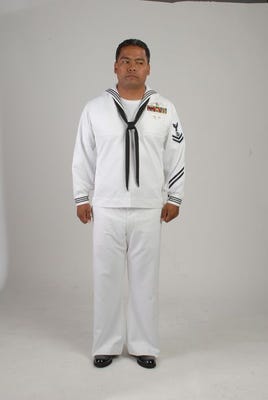 The goal is to start issuing the updated uniforms to recruits at Naval Station Great Lakes, Ill., in 2015, Kurta said.
The goal is to start issuing the updated uniforms to recruits at Naval Station Great Lakes, Ill., in 2015, Kurta said.
"We would do it sooner, if we could," he added. "Experience tells us that that timeline is the most realistic."
Details of a rollout to the rest of the fleet have not been released.
In addition to new crackerjacks, sailors can expect a handful of additional uniform changes and updated wear rules in the near future, officials said. While not releasing details, they said the changes should be announced in an upcoming fleetwide message.
The crackerjacks approval brings to an end the long development and testing process. Along the way, some experiments were jettisoned and some goals were curtailed. For instance, officials had looked at various fabrics to make dress blues a better uniform for year-round wear. They looked at fabrics such as lightweight gabardine wool, but wear tests found that sailors still preferred wool serge, the current fabric, Kurta said.
Those sailors who have complained of see-through white fabric are still out of luck. A variety of white fabrics were tested in the hope of finding comfortable and less see-through material. However, the alternatives, such as a micro-denier fabric, had problems with wrinkling, Kurta said, or washing caused the blue piping to run into the white fabric. Designers ended up sticking with Certified Navy Twill.
"They had tried an all-year-round uniform, but it turned out it didn't work very well, so this is the same [material] as the current ones," Kurta said.
The blouse redesign centered on ease of use. Both whites and blues feature a zipper down the side to make the blouse easier to put on and take off. The zipper must be worn zipped and can be locked in place.
The side zipper was "very popular with the sailors," explained Kurta, who oversaw some of the tests.
Some sailors were excited to hear about the new uniforms.
"I totally support the dress blue changes and the dress white changes," Religious Program Specialist 1st Class (FMF) James Morales wrote to Navy Times. He added that they were worth waiting for, if it meant that officials got them right.
The zipper greatly improves the comfort factor, chimed in Fleet Master Chief (AW/SW/SCW) Scott Benning, who joked that the current jumper was closer to a "straitjacket."
Wear test for women
Another big crackerjacks change is still under consideration — whether women should wear blue crackerjack jumpers, too.
Navy Secretary Ray Mabus has directed the service to look at ways to make the appearance of female uniforms align more with their male peers. As part of this, the more than a dozen female sailors assigned to the Navy Ceremonial Guard will wear both Dixie cups and dress blues at ceremonies this winter. At two Navy bands and the Naval Academy, women will wear men's covers.
Each of the female band members in the test will get handmade uniforms.
"We've taken their measurements and we're going to make their uniforms for them," Kurta said. "Part of this test will tell us what we need to do with the blue crackerjacks to make them more wearable, if you will, for females."
Officials have also ordered a fleetwide study of women's uniforms with a focus on improving fit, comfort and appearance. And they have begun making changes based on feedback: For instance, the new white crackerjack trousers will have a shorter, better-tailored crotch after complaints from some female sailors, said Robert Carroll, head of the Uniform Matters Office.
Opinions are split among Navy women over the unisex uniform push. Some see this as a means to better fit in, while others bemoan the potential loss of more feminine uniforms. One female reader emphasized that female-specific uniforms are a way for women to balance uniformity with femininity.
"Even though we are one Navy, I still think that there should be differences," Aviation Boatswain's Mate (Handling) 2nd Class (AW/SW) Jenna Weddel told Navy Times in an email. "Women couldn't always serve in the military, and maintaining some type of differences in uniform may give them something to feel apart [from] men and have a sense of femininity."
Uniform officials have also ordered a body type review, a two-year study that will measure 5,000 sailors — half men, and half women. Each participating sailor will have 96 measurements taken, such as inseam, size, head circumference and foot length, according to Carroll. Officials will then use the results to better size uniforms for sailors or to decide what changes are needed. That could lead to uniform sizes for specific body types or changes to gear as varied as gas masks, protective firefighting clothing, airplane cockpits and more.
One female reader hoped that this study would lead to changes in body armor fit.
Construction Mechanic 3rd Class Tabatha Long was issued a body armor vest before she deployed to Afghanistan in August 2009. She was given a size medium, mostly to accommodate her bust. But in all other places, the body armor was too loose. In an email to Navy Times, she recalled that the shoulders were too wide and the arms holes were gaping. She wore the armor a couple of hours a day during her 10 months at Camp Leatherneck and said it frequently shifted around, chafing her.
"Uniform fit is a real issue to women," she said. "As a servicewoman, believe me: Body armor needs to be well-evaluated."




